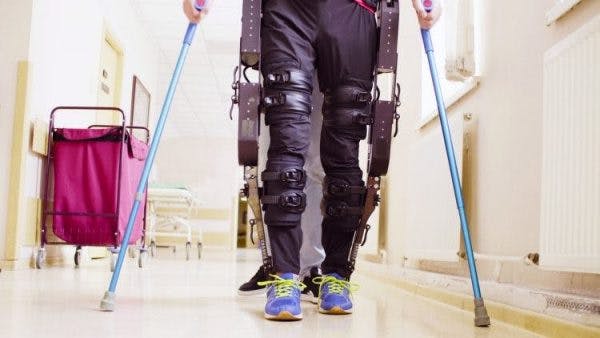Spinal shock describes the temporary loss of all reflexes, sensation, and motor control below one’s level of spinal cord injury. Often, it isn’t until spinal shock subsides that individuals develop a better understanding of what functions are or are not affected by spinal cord injury (SCI).
While it can be frightening to experience spinal shock after spinal cord injury, it can also be comforting to find out that your injury may not be as severe as it initially seemed and that there is potential for functions to return.
To help you understand what spinal shock is, this article will discuss its:
What Causes Spinal Shock?
While the underlying mechanisms of spinal shock have yet to be fully understood, it’s suggested that spinal shock is caused by swelling following damage to the spinal cord. Generally, swelling peaks at about 3-6 days post-injury.
Immediately following SCI, the body attempts to heal itself by activating an inflammatory response. This triggers an outbreak of biochemical reactions in an attempt to protect and stabilize the spinal cord. However, these processes are harsh and can cause secondary damage in the form of cell deaths, inflammation, swelling, and reduced blood flow.
Swelling of the spinal cord can further restrict blood flow, which disrupts the delivery of oxygen and other essential nutrients to tissues. As a result, autoregulation (the ability to maintain a constant blood flow) below the level of injury becomes impaired. Our bodies need blood to fuel cellular activity. Without sufficient amounts of it, cells may be damaged and the body can start to dysfunction.
Due to the complete loss of motor control and reflexes below the level of injury during spinal shock, it is possible to mistake an incomplete spinal cord injury for a complete one. It isn’t until the swelling subsides that functions innervated below the level of injury may begin to return. Make sure to speak with your medical team about whether they believe you are in spinal shock or not.
In the following section, we’ll discuss the signs and symptoms of spinal shock.
Signs and Symptoms of Spinal Shock

Depending on the amount of time that has elapsed since their initial injury, individuals tend to experience various signs and symptoms of spinal shock. Additionally, the more severe the spinal cord injury, the greater the risk of experiencing spinal shock.
Signs and symptoms of spinal shock include:
- Loss of reflexes
- Loss of motor control
- Low blood pressure (if the SCI occurs at the T6 level or higher)
- Decreased heart rate (if the SCI occurs at the T6 level or higher)
- Flaccid paralysis
- Urinary retention
- Fecal incontinence
- Spasms/ increased muscle tone
- Loss of sensation
Generally, individuals with spinal shock go from one extreme to the other. Initially, they experience flaccid, limp muscles and an absence of reflexes below their level of injury. Then, symptoms transition to a state of hyperreflexia, where the muscles become extremely reactive to stimulation.
Outlined below is a quick overview of the 4 phases of spinal shock:
- Phase 1: areflexia (absent reflexes)/hyporeflexia (below normal reflexes), flaccid paralysis, loss of sensation
- Phase 2: initial reflex return
- Phase 3: early hyperreflexia (overactive reflexes)
- Phase 4: spasticity/hyperreflexia
In the following section, we’ll discuss the duration of spinal shock.
How Long Does Spinal Shock Last?
Depending on the severity of the injury, spinal shock can last for days to weeks. The average duration of spinal shock is 4-12 weeks.
If a patient has no motor control or sensation following SCI, a physician usually checks for a bulbocavernosus reflex, and/or anal reflex. If the anal sphincter does not contract with stimulation, it indicates that spinal shock is present.
While an official consensus has yet to be reached, many define the conclusion of spinal shock as the return of the bulbocavernosus reflex, the recovery of deep tendon reflexes (such as the knee-jerk response), or the return of reflexic detrusor activity (contractions of the bladder wall).
Even after an individual is no longer in spinal shock, they will likely continue to experience spasticity. However, they will now have a better understanding of which sensory and motor functions are affected by their SCI.
Up next, we’ll discuss whether it is possible to minimize the effects of spinal shock.
Spinal Shock Treatment

Early medical intervention is crucial in the treatment of spinal cord injuries. By stabilizing the spinal cord as quickly as possible, the individual’s medical team may minimize the progression of swelling and other secondary processes that contribute to spinal shock. This helps reduce overall damage to the spinal cord.
As a temporary outcome of spinal cord injury, spinal shock should resolve on its own. Once swelling of the spinal cord starts to die down, blood flow should be restored and individuals may experience a gradual return of reflexes, sensation, and motor control below their level of injury.
The return of any sensation, motor control, or reflexes below the level of injury is an excellent sign of recovery. It indicates the SCI is incomplete, meaning that neural connections between the brain and areas innervated below the level of injury exist. Those spared neural connections are capable of using neuroplasticity (the central nervous system’s ability to adapt and reorganize itself) to potentially recover affected functions.
The most effective way to promote neuroplasticity after spinal cord injury is through highly repetitive and task-specific practice of affected movements. Continuously practicing weakened functions will help reinforce demand for them and encourage the spinal cord to make adaptive changes.
By participating in an intensive rehabilitation program, individuals can learn effective exercises and activities to promote neuroplasticity, maximize their mobility, and regain their functional independence.
Understanding Spinal Shock: Key Points
If you’re experiencing a complete loss of reflexes, sensation, and motor control below your level of injury, ask your physician about spinal shock. Often, some functions may return as swelling subsides and blood flow is restored.
We hope this article helped you understand that the initial outcomes of a spinal cord injury are not always permanent and with time, functional outcomes may improve.











